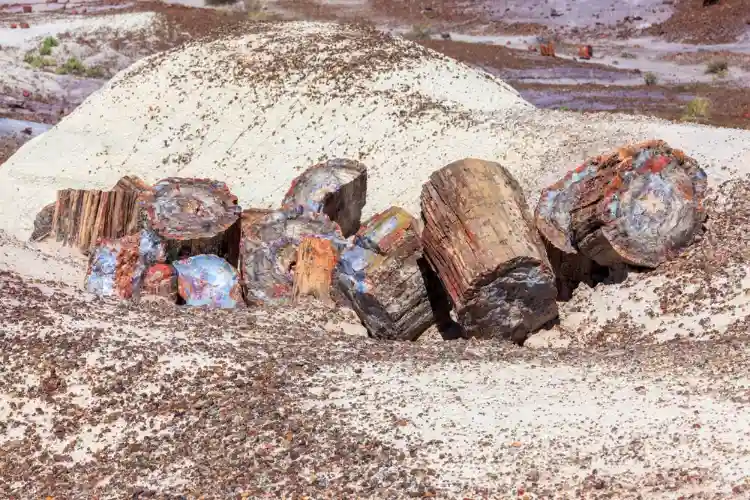A Timeless Voyage: The Creation of Petrified Wood
Nestled in the northeastern corner of Arizona, the Petrified Forest National Park offers a captivating journey through time, with its awe-inspiring petrified wood serving as a testament to the planet’s geological history. This natural wonder reveals the fascinating story of transformation and preservation that began over 225 million years ago, during the Late Triassic period.

From Lush Forest to Stone: The Process of Petrification
During the Late Triassic period, the area now known as the Petrified Forest was a vibrant tropical forest filled with towering conifer trees. Some of these ancient giants reached heights of up to 200 feet and boasted trunks as wide as 9 feet in diameter. When these massive trees eventually fell, they were quickly buried by layers of sediment from frequent tropical storms and nearby volcanic eruptions.

This rapid burial played a crucial role in the petrification process. By shielding the fallen trees from decay, the lack of oxygen and harmful organisms allowed for the slow transformation of the wood into stone. Groundwater rich in minerals from volcanic ash gradually replaced the original organic material with minerals such as silica, calcite, and sometimes even precious opal.
A Stunning Metamorphosis
The result of this extraordinary transformation is a breathtaking array of petrified logs, each one showcasing a dazzling spectrum of colors. The infusion of minerals like iron and manganese into the wood has given rise to striking hues, from vibrant reds to deep purples, blues, and greens. These colors, along with intricate patterns of mineral deposits, make each piece of petrified wood unique, creating a mesmerizing visual display for visitors.

The Petrified Forest National Park: A Window into Earth’s Prehistoric Past
Revealing a Forgotten Landscape
Over millions of years, natural erosion has gradually uncovered the Chinle Formation, exposing the petrified wood hidden beneath the surface. As the softer surrounding rock eroded away, the harder, mineralized wood became visible, revealing these ancient fossils to the modern world.

A Rich Prehistoric Ecosystem
While the petrified wood is the park’s most famous feature, the Petrified Forest National Park offers much more. The landscape is also home to fossils of ancient plants and animals that once roamed the area, including giant amphibians, crocodile-like reptiles, and some of the earliest dinosaurs. These fossils provide a vivid picture of the prehistoric ecosystem that existed here millions of years ago.

Ongoing Challenges in Preservation
The beauty and rarity of the petrified wood have unfortunately led to its theft. Despite efforts to protect and preserve the park’s natural treasures, around 12 tons of petrified wood are reported stolen each year. This ongoing problem highlights the need for continued conservation efforts to ensure that these ancient relics remain accessible for future generations to experience and appreciate.

An Enduring Natural Wonder
The Petrified Forest National Park is a remarkable example of nature’s power to preserve the past. Each piece of petrified wood tells a story that spans hundreds of millions of years, offering visitors a rare glimpse into Earth’s distant history. As a geological and natural treasure, the park serves as a poignant reminder of the forces that shaped our planet and the lasting beauty of the natural world.

